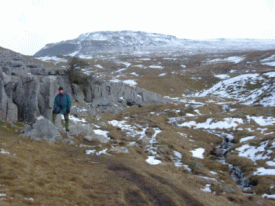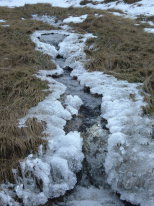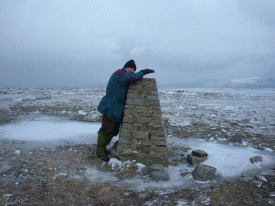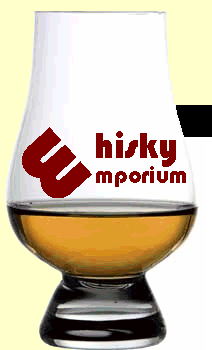|
Wednesday 30th; Whisky Awards - 2009 or
"The good, the great & the ugly"
The dust has almost
settled on 2009 and the hopes of a happy and prosperous 2010 are
just around the corner, but not yet. One of the most anticipated
events of the year is about to be announced. Yes, here are the
Whisky Emporium awards for 2009.
Without further ado,
pomp, circumstance or pontification, here are my personal awards
for 2009:
Distillery of the year 2009
This was not such
an easy choice for me to make as there were many contenders, but
a decision had to be made and it goes to
Glengyle
for their Kilkerran
Work in Progress!
Congratulations to
all at Glengyle. This was your first release of Kilkerran at 5
years and I have to say it is already a very good whisky and
shows great promise for the future.
The runner-up
and closely in second place is
Kilchoman,
well done to Islay's newest and smallest 'farmhouse' distillery
for your three-year expression and first whisky launched this
year. Once again this shows amazing prospects for the future.
Best new release of 2009
For me there can only be one
winner in this category;
Hazelburn 12y
Congratulations!
This is a fantastic whisky which has matured marvellously since
the release of the 8y variant. It shows a rich depth of flavours,
warmth and complexity that make it a memorable dram for me.
My three favourite whiskies sampled in 2009
This category is
not about whisky released in 2009, but ones I tried during this
last year and, it seems, 1969 was a jolly good year!
1st Place:
Glen
Mhor 1969,
distilled 1969,
casks 1407-1409, bottle 907 of 2265,
45%
ABV
Fruity,
light, fragrant, but at the same time herbal, rich and complex.
A sublime whisky.
2nd Place
goes to
Tamdhu 1969,
distilled 1969,
bottled 2004,
34y,
40%
ABV, Duncan
Taylor 'Auld' range.
Very intense and
floral apples, violets, liquorice and dry fino sherry.
Marvellous!
3rd Place is awarded to
Glenglassaugh 1973 'Family Silver'
Leather, herbal hay
and rich fruit soaked in amaretto. Complex, fruity luxury in a
glass.
The 'dud' of the year
is awarded to
Bruichladdich Waves,
the original presentation.
This is quite a
decent dram when the bottle is first opened, but if left only
for a matter of a week or two, a strange sediment forms at the
bottom of the bottle and this signifies the whisky is now
undrinkable! Turning it from a lively 7 year old into a musty,
rancid old beast which is best poured down the drain. Oh dear,
what went wrong at Bruichladdich with this one?
Finally,
Best whisky Glass of 2009:
The Classic Malt glass!
2009 was the year
when I finally ran an in-depth analysis of whisky glasses
(which can be found here)
and the outright winner was The Classic Malt glass, with the
Glencairn in second place and Spiegelau a close third.
Sunday 27th; Twixt the years or
"A walk on the cold side"
As you know I
currently live near to Munich in Bavaria, but at heart I am
still a Yorkshireman and, although there really isn't very much
I miss from my homeland, today rekindles memories which make me
wish I were indeed back there in one specific, small and very
beautiful corner of Yorkshire.
I was extremely
fortunate to be introduced to the beauty of the Yorkshire Dales
at the age of about 12-13 when the school I attended managed to
buy an old Coaching Inn located in the village of
Horton-in-Ribblesdale, the village at the heart of the
'Yorkshire Three Peaks' which are three hills named Pen-y-Ghent,
Ingleborough & Whernside. Together they form a 27 mile round
walk where each hill is just over 2000 feet high. There is even
an antique (workers) clocking-in machine at the famous
Pen-y-Ghent cafe in Horton-in-Ribblesdale where walkers have the
ability to declare the start of their walk and if completed
within 12 hours they qualify for membership of the 3-Peaks Club.
Anyway, back to
that pub, The Golden Lion had accommodation for around 30 people
so the school converted it into an outdoor centre and pupils who
stayed there, usually for long weekends or a full week were
introduced to The Dales and fell-walking or hiking in the area.
So deep-routed in my heart were these breaks and also this area,
I returned many times long after leaving the school and starting
work. In fact the one fixed time when I always re-visited the
village, usually only for a one-day walk was during the days
just after Christmas Day and before the New Year. This was my
pilgrimmage, one which I usually faced alone and for some reason,
I tended to prefer the challenge of Whernside, the highest
of the three hills at just over 2400ft. The surrounding scenery
is beautiful and dramatic as it sits right alongside the even
more famous Settle to Carlisle railway line with the Ribblehead
viaduct sitting right at the foot of the hill.
But what has
this to do with whisky? Please stay with me, all will be
revealed.
I'm sure you can
imagine the scene; a clear, crisp, cold day, often shrouded in
snow or sheet ice, but for some lucky reason I hardly ever faced
rain on these days. I would set out from home in the early
morning, drive for about an hour and a half and aim to start my
walk by around 10am. Lunchtime would be spent atop Whernside
with the obligatory turkey sandwiches, a piece of Christmas cake
and a flask of piping hot tea with 2-3 cardamom seeds for an
invigorating freshness.
Sitting atop
Whernside I would further reflect on my previous hikes in the
area and inevitably upon growing up with many trips into The
Dales and very long, very hard days of hiking which at the time
could only have been called 'character building', but which, as
I already mentioned, gave me a very deep-routed love for the
region.
OK, now for the whisky bit.
I have often told
how a certain whisky can remind me of a long-ago time or
experience and this is yet another example. I will never forget
the time I first tried a Caol Ila at cask strength (almost 60%
ABV). The nose was one of gentle peat and wood-smoke, it was
unique in its ability to convey this sense of both peat and
wood-smoke and it immediately flicked a switch in my brain, one
which is still active today and which for many years I returned
to the area to re-live in the days just after Christmas.
Yes, I need to take
you back to those school days when I was in my mid-teens and our
target was the Summit of Whernside, but instead of a school bus
to take us there, we were walking from Horton via Ingleborough
and some would even continue to return by Pen-y-Ghent and
complete all three peaks, but I digress.
This walk is never
too far from civilisation, but it is long and difficult and the
leaders need compass skills. Anyway, we had already climbed a
couple of smaller hills on our way to Ingleborough, the day was
wintry and bleak and discomfort was beginning to set in when we
suddenly had a view across to a small hamlet of just a few
cottages, a symbol of civilisation which somehow gave a
comforting feeling, especially so with the gently smoking
chimneys. These houses had no central heating at that time, so
the warmth was gained from their real fires where they tended to
burn a mixture of peat and wood.
I had no idea the
effect those cottages and that day would have on me in later
life, in fact I had totally forgotten about it until that
fateful day many years later when I was introduced to a Caol Ila
CS, or should I say, I was immeditely transported to my youthful
outdoor days of The Dales.
This still lives
with me today, each time I nose a CS Caol Ila I am back in the
middle of a Dales Fell, on my long hike to Ingleborough and
Whernside on a very cold, but no longer dismal, wintry day.
So, as I have sat
many times since atop Whernside, Ingleborough or even
Pen-y-Ghent, I have always spared a thought over my lunch of
turkey butties and hot tea for those long-ago hikes magically
symbolised in a glass of superb whisky. Those cottages still
exist, although I understand some are now converted to holiday
homes and have probably been much modernised in the last
thirty-odd years, but their memory will never leave my Caol Ila,
especially today when had I been able to get to that area, I
would have again sought the pilgrimmage of my youth.
The last time I had the pleasure of this pilgrimmage was in 2006
when I returned to The Dales with an old school friend and for
that day, we chose a very difficult, icy and treacherous
Ingleborough;



Friday 25th; Make a little time for yourself today or
"My definitive Christmas dram"
Merry Christmas,
happy holidays and season's greetings to all. I don't know what
today means for you, but for me it's a time to spend with loved
ones, to give gifts and to celebrate our life together, so I say
to my dear wife "Sabine, I love you, thank you for just being
there and I sincerely hope we share many more years and
Christmasses together".
As I think about
Christmas my mind is also drawn to whisky as many drams offer
the types of flavour we associate with this time of year. Some
time ago I offered a certain whisky as my definitive 'Christmas
dram', but some of the guests on that tasting disagreed with my
train of thought. Although they agreed with my taste profile,
their own culture associates different flavours with this time
of year, with more light marzipan and gentle nut flavours,
rather than heavier, rich dark fruits.
What was that whisky? Let me take you on a short journey of
discovery.
Imagine the scene;
It's Christmas day in an Olde English country house, or more
fittingly a Scottish Castle and your family have travelled from
far and wide to be together. Breakfast and lunch were lavish
spreads of locally sourced produce, conversation was brimming
with family news and even some small gifts were exchanged. Then,
in the afternoon you decide to retire to your study; A room
lined with old oak bookshelves, themselves laden with musty old
books, many are leather-bound first editions. You gently relax
into your favourtie deep-buttoned leather armchair and pour
yourself a glass of your finest sherry.
At this point you
may be forgiven for asking what this has to do with whisky, but
my reply would be that this would be my definitive Christmas
afternoon. Perhaps an hour to myself in such a study. So I was
extremely happy when I found the perfect dram which immediately
transported me into this fantasy.
Pulling the cork on a new bottle immediately releases the mixed
aromas of rich leather, old oak and even the mustiness of those
old first editions, unopened and unread for some years now. As
the whisky settles the aromas change slightly to include more
sherry and those dark fruits of the finest Christmas pudding.
Did I say fantasy?
The location may be, but the whisky is very real - welcome to
Glenfarclas 'Quarter Casks, 1987' My definitive Christmas
whisky, what's yours?
Slàinte and a Merry
Christmas to all from Dram-atics!
Thursday 17th; Deck the hall with boughs of holly, 'Tis the
season to be jolly ...
The Festive Season,
Christmas, The Holidays or whatever you wish to call it is
rapidly approaching. It's a time for families to relax, exchange
gifts, spend time together and hopefully, a time of love and
peace. It's also a time when many of us can sit back with some
of our favourite drams and reflect upon the year that was and
the one that is about to be.
Do you have a
favourite Christmas whisky? Do you like those typical Christmas
flavours often provided by first-fill sherry casks? For me,
these are certainly the drams I normally choose at this time of
year, so let me offer some suggestions and recommendations.
Macallan,
but make sure it's the 'sherry' range (and not Fine Oak) for
those wonderful, traditional flavours of rich dark fruits. The
18y fits the bill perfectly, but if your budget doesn't
run to that I can highly recommend the 10y Cask Strength.
Dalmore is
another of those dark, rich, deep drams with all the flavours of
this time of year and if you're lucky, they even have hints of
spiced orange too. As for which one? my palate says "the older,
the better" so tailor your dram to your budget accordingly, you
won't be disappointed.
Aberlour
offer some great sherried drams, but absolute foremost are the
A'Bunadh batches and although the great batch numbers 3,
6, 14 & 20 are probably long-gone from the shelves, you still
shouldn't be disappointed with the latest ones.
Glenfarclas
is another name synonymous with Christmas. A great distillery
with some fantastic cask selection policies. If you can find
them, try some of the vintages or the 'quarter casks' if you
like your Christmas cake and pudding all together in a single
glass!
My list is far from
definitive, but it will certainly help you find what I think are
very good Christmas drams so if you haven't already given your
present-list to Santa, do it today and say I sent you!
What is my favourite Christmas dram? I'll let you know on
Christmas Day, 25th, Merry Christmas!
Thursday 10th; Protecting Scotch whisky but not most of it!
On Monday 30th
November new laws came into force regarding Scotch whisky, its
production, its bottling, its labelling and even its marketing,
so let's have a look at some of the salient points of these new
laws.
Scotch Malt
Whisky must be produced at a distillery in Scotland, matured
within Scotland in an authorised warehouse for a minimum of 3
years in oak casks not exceeding 700 litres. Only water and
caramel colouring may be added and it must have a minimum
strength of 40% ABV.
Single Malt
Scotch whisky must also be produced in Scotland at one
single distillery from water and malted barley (with no other
cereals being added!) and it must be distilled in pot stills.
Well, we're looking
quite good so far; Scotch must be produced and matured in
Scotland and when it comes to Single Malt, seemingly by
traditional methods including pot stills. But this immediately
brings one distillery to mind who use not only two 'traditional'
pot stills, but also four 'Lomond' stills and one continuous
column (or Coffey) still in their whisky production. Yes, Loch
Lomond (who are not members of the SWA) are pretty unhappy about
this new law which they say immediately wipes GBP 3.5 million
off their current stock alone, which can no longer be called
'Single Scotch Malt'.
Loch Lomond story here.
At this time I
should also mention that the new laws also define five different
names, or categories, of Scotch whisky that must be used; Single
Malt Scotch whisky, Single Grain Scotch whisky, Blended Malt
Scotch whisky (previously referred to as 'Vatted' whisky),
Blended Grain Scotch whisky & Blended Scotch whisky.
Great: No
more 'Pure' silliness here then!
So far all seems to
be looking good for the protection of Scotland's great gift to
the world (my words), but let's look a little deeper at some of
the other little goodies in the new laws, especially when it
comes to movement and bottling as there is currently much debate
as to whether Scotch whisky should be bottled in Scotland.
Hopefully the new laws make this clear?
Single Grain, Blended Grain, Blended Malt & Blended Scotch may
not be moved "from Scotland to another country in a wooden
cask or other wooden holder"
Until (and including) 22nd November 2012 Single Malt Scotch
whisky may not be moved "from Scotland to another country in a
wooden cask or other wooden holder"
From 23rd November 2012 Single Malt Scotch whisky may only be
moved from Scotland in a bottle (made from any material) that is
labelled for retail sale.
Great again?
Scotch whisky must be bottled in Scotland? Errmm no, not quite,
you may call me an old cynic but only Single Malts actually have
to be bottled in Scotland from 23rd November 2012, until that
date they may not be transported outside Scotland in casks or
other wooden containers. So, for any of you who may own a
distillery or two, you have almost three years should you wish
to get any of your matured Single Malts out of Scotland for
bottling in other (perhaps much cheaper) countries, just don't
use wooden containers.
As for the other
four categories (which include Blended Scotch) there is no
cut-off date, they just can't be moved in anything wooden and as
Blended whisky only accounts for around 95% of all Scotch sales(!)
I guess it doesn't matter that only 5% of Scotch must actually
be bottled in Scotland, just make sure you keep all the wood in
Scotland.
Finally, what
about the Islands? I like to associate my Scotch with
geographical regions and have always acknowledged and spoken of
what I believe to be the six within Scotland; Lowland, Highland,
Campbeltown, Speyside, Islay & Islands and I'm pleased to see
that the new laws go as far as far as 'protecting' them, all
five of them so nobody can use the term 'Highland' for any
whisky unless it was distilled in a Scottish Highland distillery,
with the same rule governing the use of 'Lowland', 'Speyside', 'Campbeltown'
& 'Islay'.
Did I say five? My
sympathy to the poor unrecognised 'Islands', I'll give you a
good home if nobody else wants you.
Finally, finally
back to maturation; Don't mention the terroir!
Link to the full extent of the new laws
The last word from Paul Walsh, Chairman of
the SWA & Chief Executive of Diageo "It
is a defining moment for Scotland's distillers. We have been
distilling whisky in Scotland for more than 500 years and today
landmark rules covering every aspect of the making, bottling and
labelling of Scotch whisky come into force."
.....But
not most of it! (My words)
Wednesday 2nd; Time Please, last orders or "All power to
the bean-counters"
For sale; only 112
years old, three careful owners and full service history. Oh how
I wish it were openly for sale almost as much as I wish I had
the cash or even the backing to buy it.
Sadly, after 112
years we hear that Edrington Group have decided to stop
production at Tamdhu distillery. This move will take effect in
April 2010 as the distillery will be reduced from production to
"care and maintenance".
This won't be the
first time Tamdhu has been 'closed' as it saw a brief closure
between 1911-13 and then a longer one for 20 years between
1928-48, so here we are again after the expansion of the 1970's
when Tamdhu's stills were increased from two to six and the 8y
Single Malt bottling was introduced, but now all this may have
been in vain as it is about to close again.
Tamdhu is owned by
Edrington along with The Macallan, Glenrothes and Glenturret but
these are being pretty well left alone as for various reasons
they seem to be viewed as 'the jewels in the crown' and only Tamdhu - the poor
relation will suffer closure as an Edrington statement announced
that they want to ensure "the business is the right size and
shape to support current and future activity levels."
So what are these
activity levels? I personally can only guess at this, but as
most companies are looking towards the emerging markets of
China and India along with a growing demand for single malts, they see the need to increase
production to meet projected demands. Even the Scotch Whisky
Association have recently said that more money is being invested
in whisky since the late 1960's. "The
Chinese have bought into Scotch whisky,” Gavin Hewitt,
chief executive officer of the association, said “There’s
a huge new middle class and they want to make a statement about
themselves.”
This leaves me
baffled and I have to ask myself "why would Edrington
rather lose 31 valuable employees and ramp-down production,
blaming the 'economic situation' when their competitors seem to
be doing exactly the opposite?" Well, I may be wrong here,
but I haven't seen any report saying Edrington is not making a
profit or losing money. I have only seen ones saying they aren't
making enough profit, so they choose to close a distillery and
throw valued employees onto the streets! Maybe the answer lies
in something I read on The Macallan's own website, which is also
true for their other distillery shops;
"Please
bear in mind that regrettably, if you are outside of the UK it
is not possible to purchase whisky through the Online Shop."
Maybe
they want to conquer the UK and leave the rest of the world to
their competitors! (OK, only joking, we all know The
Macallan is a world-leading brand and for some the definitive
Christmas present, but I am still dismayed and extremely
disappointed when I see distillery closures).
But what of the
whisky? Well, Tamdhu is a major component of Famous Grouse
blended whisky and this is indeed where most of the production
goes. So a new recipe will be needed for this flagship blend.
As for Tamdhu as a
single malt; I only recently discovered this and after hearing
so many reports saying it is one of the best value single malts
around, I can only agree! It was a very enjoyable dram at a
great price. In fact, my
tasting notes are here.
Is there hope? Well
I for one can only hope someone sees the true value of this
distillery and prises it from the Edrington stable, perhaps
giving it a little rejuvenation and turning it from an unwanted
'ugly sister' into a true 'Cinderella'.
Slàinte
|

